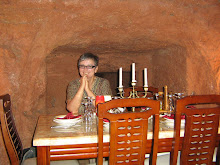
I've had such a full week delving into the neolithic sites in Malta and Gozo that Saturday is turning out to be a day of collapse. I have so much material to get up on to the blog that I am almost stalled so I've decided to be gentle on myself and tackle one thing at a time. This first post for November will be following up on my previous post about the military and naval fortifications.
I returned to the Maritime Museum in Birgu for a lecture given by the young man who had so impressed me on the fortifications trail. It transpires that he is the curator of the Museum and is currently completing his Masters degree on the naval history of Malta. The lecture drew on the diary of a Maltese man, Don Ignatio Mifsud, who wrote in detail about his sea journey from Valletta to Rome in 1746. He was traveling to be ordained as a priest but wrote lovingly about the meals they had on the way and the various stops made over the 2 and a half week journey. It seems the trip at that time generally took about one week but Ignatio tarried longer than he should have in Castelamara near Naples where he met a beautiful woman and flirted for two days.
The boat they sailed in was 20 metres long and a bit like a Maltese luzzu but with a low freeboard so it was very sensitive to bad weather which they encountered several times along the way. On the first day, after beaching at St Julian's to cook their dinner, it took them only 2 hours to cross to Sicily. This is about the same time as it takes the fast ferry to get across today! The diary gives all the ports of call along the way up the coast of Italy to Rome together with details of the food they prepared at each stop, bad weather encountered and run-ins with customs officials whom they mistook for bandits! The journey was the exact reverse of the trip that Carol and I had made by train, bus and ferry to get from Rome to Malta. I am still promising to post the story of our journey but I wish now that I had kept as detailed a journal as Ignatio did. After being ordained, Mifsud returned to Malta where he worked as a priest and published his story in Maltese using the printing press that had been established in Malta under Lascaris and was re-established in the 1740s. He is buried at Floriana.
After the lecture, I slipped out without the offered maritime coffee because I needed to get back to Valletta before my last bus to Marsaxlokk left. A short stroll across the promenade and I was able to jump in a dghajsa for the magic night trip across the harbour. The spelling I've used here for the traditional Maltese water-taxi is taken directly from a postcard that I bought this week on Gozo. It seems that I got the spelling wrong the last time I posted but I was quickly corrected by one of the participants in another site I've been invited to join called Global Friends of Malta. There are some sounds in Maltese that can't be represented easily in a Roman alphabet and the 'h' in dghajsa should have a cross bar on the upright.
The dghajsas drop passengers off at the old fish market at Valletta. Like many of the buildings in Valletta, this building now rests unused awaiting a future. Valletta is a UNESCO listed heritage site and the residential population has been steadily declining over the past century. I am beginning to think that that trend will start to reverse soon and already there is growing debate about the kind of capital city the Maltese people would like to have. In 2016, Valletta will be 450 years old and I went to a half day seminar run by the Valletta Alive Foundation about the future of the city. I have also been investigating the possibilities of buying a flat in one of the three villages of the city. I will post a blog soon about those two ventures, but for now, I'll just promise the next post in the vague sequence that seems to form as I write and that will be the story of our journey from Rome to Malta made nearly two months ago now but still unreported in the rush of images and ideas and feelings as I settle in Malta.

No comments:
Post a Comment